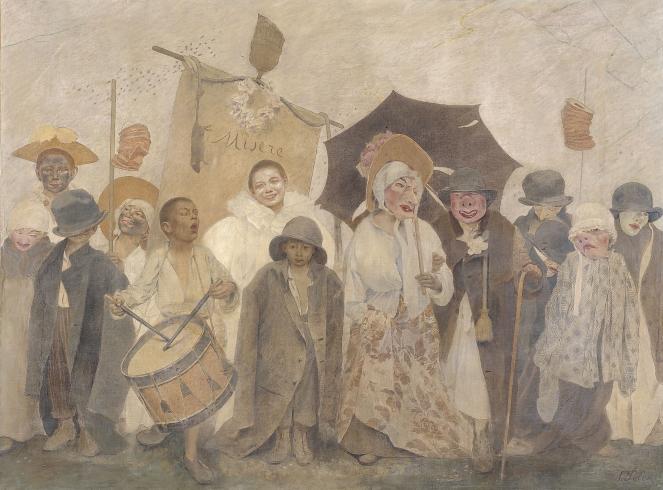Thirteen children move forward in a closely-bunched line to the sound of a drum under the banner of Poverty. Here, Fernand Pelez, a painter from Montmartre, gives us his version of the Vachalcade, a people’s carnival held in Montmartre in March 1896.
The Vachalcade was a Montmartre festival with processions and a themed float parade, intended to create an assistance fund for artists living in poverty. Its name came from a contraction of the words "vache" and "cavalcade", in reference to the traditional fat ox festival on the third Thursday in Lent.
Here Pelez depicts a group of children wearing costumes and face paint. Their over-sized clothing parodies the world of adults by making fun of the bourgeois codes to which these bowler hats and floral bonnets belong. In the right hand section of the painting, the faces are totally hidden behind masks, with distorted mouths highlighted in red. In the centre, there is a smiling Pierrot dressed in white with his face covered in flour. His attitude expresses cheerfulness tinged with irony, in the manner of the figures popularised by Adolphe Willette, one of the artists who was greatly involved in the organisation of the procession.
There is no backdrop for this street scene, just a simple cracked wall behind the frieze of children who seem to be posing for an invisible photographer before resuming their march. The underlying drawing can be faintly seen beneath the oil paint applied in fine beige and pink layers. These muted tones create the impression of a fresco painted directly onto the wall.
The painting’s origins are shrouded in mystery, as Pelez never exhibited this large canvas outside of his studio. The location of the preparatory paintings, which are visible in the photographs taken of the studio in 1913 after the painter's death, is currently unknown. Pelez first of all studied each figure separately, then in small groups painted on the same scale as the final painting. La Vachalcade was one of the revelations of the posthumous exhibition in 1913 held at 72 Boulevard de Clichy. The painter's sisters then donated it to the City of Paris.
I. C.

City of Paris municipal collection's website
The collections portal can be used to search the collections of Paris’s 14 municipal museums (approximately 336,000 works, including 43,000 belonging to the Petit Palais).
It is also possible to download around 12,000 images of the museum’s works free of charge.
Access the Museums of the City of Paris collections portal
Extern databases
Discover a selection of databases online presenting works from the Petit Palais or documents concerning the history of the museum.

